Armillaria species Key to North American Armillaria species
using macroscopic, microscopic and distributional characters
This is another tentative key that still needs a bit of work.
Stay tuned for further details! If you have comments write to me at volk.thom@uwlax.edu
1. Annulus lacking ................................................................A. tabescens
1. Annulus present..................................................................2
2. Pileus smooth, stipes pointed at the base, thick wooly annulus, no clamp at base
of basidium or anywhere in basidiomata,
dist. mainly east of Rocky Mountains...................................A. mellea
2. pileus smooth or scaly, pointed or non-pointed stipe bases, at least some basidia basally clamped................3.
3. orange brown pileus, no scales, brown stipe, virtually all basidia basally clamped,
second basidium emerges from clamp of first, dist. western North America, on hardwoods
.....................A. nabsnona
3. pileus brown to yellow brown, scales present or absent, more widely distributed..........4.
4. Annulus thick, scales on pileus, basidiomata often clustered, with pointed stipe bases.... ..5
4. Annulus cortinaceous (arachnoid, cobwebby), pileus not scaly (may have hairs), basidiomata clustered or single..............6
5. on hardwoods, Eastern distribution, apparent distribution from Québec south to North Carolina.
not known west of the Appalachian Mountains..... A .gemina
5. on hardwood or conifer, widely distributed through northern tier of states and throughout Canada, severely pathogenic.......A. solidipes
6. rare species in North America, apparently restricted to Washinton and British Columbia, on hardwoods,
often with deceptive double-appearing annulus. ....... NABS XI
6. more widely distributed, annulus arachnoid, not appearing double............................7
7. some annulus cells greater than 8 µm diameter, on hardwoods in the East, on conifer in the West..
................A. sinapina
7. All cells of annulus less than 8 µm diameter, non pathogenic species, mostly east of the Rocky Mountains,
rare in the west....8
8. indistinguishable from each other. A.gallica, A.calvescens
Morphological descriptions of species.
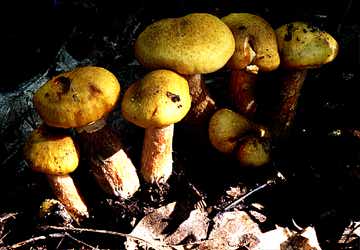 Armillaria mellea (Vahl:Fr.) Kummer.
Although this name was widely used for nearly all
members of the genus until the 1970's, true Armillaria mellea has a smaller distribution,
occurring mainly in the southeastern United States up into the northeast into Québec and in
the midwest in the hardwood forests, although it is occasionally found on conifers in mixed
forests. It has been reported from northern California, but is not common in the west.
Although A. mellea is the type species of the genus, it is rather different than the other
species, and is relatively easy to identify with practice. It is characterized by is clustered
caespitose habit, usually 8-10 but sometimes in groups of 30 or more, which results in a
tapered to pointed base on each individual stipe. The pileus is honey colored and the surface
is smooth, with no squamules. However, the most consistent character of this species is
microscopic; this is the only species of Armillaria that lacks clamp connections at the base of
the basidia. Spores 7.2-8.9 X 5.6-6.7 µm.
Armillaria mellea (Vahl:Fr.) Kummer.
Although this name was widely used for nearly all
members of the genus until the 1970's, true Armillaria mellea has a smaller distribution,
occurring mainly in the southeastern United States up into the northeast into Québec and in
the midwest in the hardwood forests, although it is occasionally found on conifers in mixed
forests. It has been reported from northern California, but is not common in the west.
Although A. mellea is the type species of the genus, it is rather different than the other
species, and is relatively easy to identify with practice. It is characterized by is clustered
caespitose habit, usually 8-10 but sometimes in groups of 30 or more, which results in a
tapered to pointed base on each individual stipe. The pileus is honey colored and the surface
is smooth, with no squamules. However, the most consistent character of this species is
microscopic; this is the only species of Armillaria that lacks clamp connections at the base of
the basidia. Spores 7.2-8.9 X 5.6-6.7 µm.


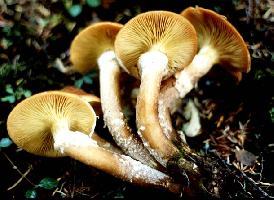 Armillaria solidipes (Romag.) Herink. This species is mostly restricted to conifers and is a
serious pathogen of many species in the northern conifer zone. It is also found in caespitose
clusters, sometimes pointed at the bases of the individual stipes, with a brownish annulus.
The pileus is brown colored, covered by dark scales, and can be very large, up to 1 foot in
diameter, especially in the Pacific Northwest. This is the species that has been reported to
cause some people some gastrointestinal upset if collected from hemlock, but we believe that
most of the reported upset is due to undercooking (and overeating) of some of these larger
collection. Spore size 8-11 X 5.5-7 µm.
Armillaria solidipes (Romag.) Herink. This species is mostly restricted to conifers and is a
serious pathogen of many species in the northern conifer zone. It is also found in caespitose
clusters, sometimes pointed at the bases of the individual stipes, with a brownish annulus.
The pileus is brown colored, covered by dark scales, and can be very large, up to 1 foot in
diameter, especially in the Pacific Northwest. This is the species that has been reported to
cause some people some gastrointestinal upset if collected from hemlock, but we believe that
most of the reported upset is due to undercooking (and overeating) of some of these larger
collection. Spore size 8-11 X 5.5-7 µm.
 Armillaria sinapina
Bérubé & Dessureault. This species is similar in color to A. solidipes,
with similar, although somewhat smaller dark scales on the pileus. It normally occurs singly
or sometimes in clusters of two or three. In the Northeast it can be found mainly on
hardwoods and occasionally conifers, but in the Pacific Northwest (Idaho, Washington,
Alaska, British Columbia) it seems to be more common on conifers, although it is often found on aspen there
(K. Mallett, Pers. Comm.).
In the Northeast, the major morphological character that
distinguishes this species from the others is the "presence of a golden yellow universal veil
that covers young fruiting bodies and later leaves remnants consisting of yellow warts or
lumps of tissue on the cap, a yellow fibrous annulus, and many patches of fibers on the
stipe" (Bérubé & Dessureault, 1988). However, we have not observed this yellow
coloration on western specimens. Spore size 8.2-10 X 5.9-8 µm.
Armillaria sinapina
Bérubé & Dessureault. This species is similar in color to A. solidipes,
with similar, although somewhat smaller dark scales on the pileus. It normally occurs singly
or sometimes in clusters of two or three. In the Northeast it can be found mainly on
hardwoods and occasionally conifers, but in the Pacific Northwest (Idaho, Washington,
Alaska, British Columbia) it seems to be more common on conifers, although it is often found on aspen there
(K. Mallett, Pers. Comm.).
In the Northeast, the major morphological character that
distinguishes this species from the others is the "presence of a golden yellow universal veil
that covers young fruiting bodies and later leaves remnants consisting of yellow warts or
lumps of tissue on the cap, a yellow fibrous annulus, and many patches of fibers on the
stipe" (Bérubé & Dessureault, 1988). However, we have not observed this yellow
coloration on western specimens. Spore size 8.2-10 X 5.9-8 µm.
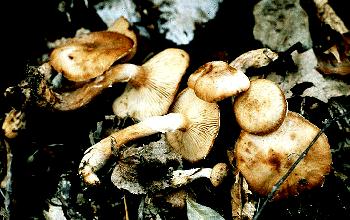 Armillaria gallica
Marxmüller & Romagnesi. This is by far the most widely distributed
species east of the Rocky Mountains, including the northeast, midwest, and gulf coast, but is
very rare in the west. It is almost always found on hardwoods, but occasionally on conifers.
It can be distinguished by its solitary to gregarious habit, usually on soil, but occasionally
"climbing" onto logs or stumps to fruit. The fruit bodies, which tend to be smaller than the
other species, are directly attached to rhizomorphs (Darmono et al., 1992). The partial veil
is cortinaceous, i.e. very similar to the cobwebby cortina of a Cortinarius species, leaving
white "arachnoid" remnants on the stipe. The pileus is "tan to pinkish brown" and
"distinctly hairy" ( Bérubé & Dessureault, 1988). The base is commonly swollen and
sometimes stains yellow where bruised. Spore size 7.2-9.5 X 4.8-6 µm.
Armillaria gallica
Marxmüller & Romagnesi. This is by far the most widely distributed
species east of the Rocky Mountains, including the northeast, midwest, and gulf coast, but is
very rare in the west. It is almost always found on hardwoods, but occasionally on conifers.
It can be distinguished by its solitary to gregarious habit, usually on soil, but occasionally
"climbing" onto logs or stumps to fruit. The fruit bodies, which tend to be smaller than the
other species, are directly attached to rhizomorphs (Darmono et al., 1992). The partial veil
is cortinaceous, i.e. very similar to the cobwebby cortina of a Cortinarius species, leaving
white "arachnoid" remnants on the stipe. The pileus is "tan to pinkish brown" and
"distinctly hairy" ( Bérubé & Dessureault, 1988). The base is commonly swollen and
sometimes stains yellow where bruised. Spore size 7.2-9.5 X 4.8-6 µm.
 Armillaria calvescens Bérubé & Dessureault. This species is very similar to A. gallica. It is
also found solitary on the soil, but is usually found in large clusters, sometimes up to several
hundred fruiting bodies, although the stipes do not radiate from a common point as in A. mellea. Pileus tan to brown, with no scales, but a finely fibrillous surface that can be easily
rubbed off, leaving a "mealy" texture between your fingers. Veil golden yellow, sometimes
not easily observed, sometimes leaving fibrils on the stipe, which is often swollen at the
base. Usually found on maple in southeastern Canada and New England, but also found on a
variety of other hardwoods west to Michigan and Wisconsin. The mycelium of this species
has also been found in the Canadian prairie provinces, although has not been observed
fruiting there (Mallett, 1990). Spore size 8.5-10 X 5-7 µm.
Armillaria calvescens Bérubé & Dessureault. This species is very similar to A. gallica. It is
also found solitary on the soil, but is usually found in large clusters, sometimes up to several
hundred fruiting bodies, although the stipes do not radiate from a common point as in A. mellea. Pileus tan to brown, with no scales, but a finely fibrillous surface that can be easily
rubbed off, leaving a "mealy" texture between your fingers. Veil golden yellow, sometimes
not easily observed, sometimes leaving fibrils on the stipe, which is often swollen at the
base. Usually found on maple in southeastern Canada and New England, but also found on a
variety of other hardwoods west to Michigan and Wisconsin. The mycelium of this species
has also been found in the Canadian prairie provinces, although has not been observed
fruiting there (Mallett, 1990). Spore size 8.5-10 X 5-7 µm.
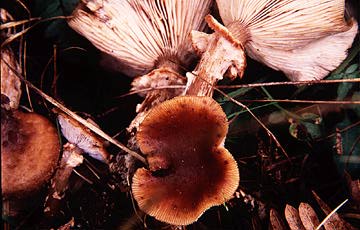 Armillaria gemina Bérubé & Dessureault. This is a rare species, reported only from
southern Québec, southern Ontario, upper New York state and Vermont, down to West
Virginia. It is identical to A. solidipes in terms of habitat and morphology
Bérubé & Dessureault., 1989, but known only from hardwoods, and apparently not a pathogen (Tom Harrington, Pers. Comm.).
It can usually be
distinguished by geography, but in areas where the ranges of the two species overlap,
(such as in New Hampshire south to western North Carolina) they
can be distinguished only in cultural studies. Spore size 8.2-10 X 5.2-7 µm.
Armillaria gemina Bérubé & Dessureault. This is a rare species, reported only from
southern Québec, southern Ontario, upper New York state and Vermont, down to West
Virginia. It is identical to A. solidipes in terms of habitat and morphology
Bérubé & Dessureault., 1989, but known only from hardwoods, and apparently not a pathogen (Tom Harrington, Pers. Comm.).
It can usually be
distinguished by geography, but in areas where the ranges of the two species overlap,
(such as in New Hampshire south to western North Carolina) they
can be distinguished only in cultural studies. Spore size 8.2-10 X 5.2-7 µm.
 Armillaria tabescens (Scop.) Emel
This is the only species of
Armillaria in North America without an annulus of any type. It is very common in the
southeastern United States, west to Texas and Oklahoma, especially as a severe pathogen of oaks and orchard trees,
but can be found into Ohio, Michigan, and Illinois, especially in
moderated climates near the Great Lakes. It is always found in caespitose clusters, usually 8-
10 basidiomata, but sometimes of 50 or more. Spore size 8-10 X 5-7 µm.
Armillaria tabescens (Scop.) Emel
This is the only species of
Armillaria in North America without an annulus of any type. It is very common in the
southeastern United States, west to Texas and Oklahoma, especially as a severe pathogen of oaks and orchard trees,
but can be found into Ohio, Michigan, and Illinois, especially in
moderated climates near the Great Lakes. It is always found in caespitose clusters, usually 8-
10 basidiomata, but sometimes of 50 or more. Spore size 8-10 X 5-7 µm.
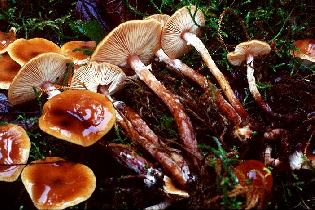 Armillaria nabsnona Volk & Burdsall
in Volk, Burdsall, & Banik, 1996, Mycologia 88:484-491
This species has an orange brown pileus, no scales on the pileus, brown stipe fading to white near the annulus,
found in gregarious clusters but not caespitose.
This species is apparently restricted to the far west coast of North America, from California to Alaska, and inland to Idaho.
It has been reported only from hardwoods, especially red alder.
Spore size 8-10 X 5.5-6.5 µm.
Armillaria nabsnona Volk & Burdsall
in Volk, Burdsall, & Banik, 1996, Mycologia 88:484-491
This species has an orange brown pileus, no scales on the pileus, brown stipe fading to white near the annulus,
found in gregarious clusters but not caespitose.
This species is apparently restricted to the far west coast of North America, from California to Alaska, and inland to Idaho.
It has been reported only from hardwoods, especially red alder.
Spore size 8-10 X 5.5-6.5 µm.
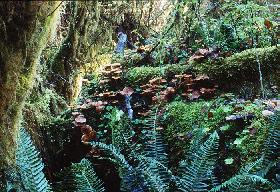
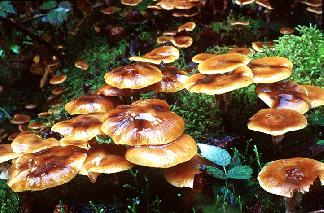 This species has a very distinctive pattern of branching in the development of the basidia.Fig 7
This species has a very distinctive pattern of branching in the development of the basidia.Fig 7

 This is NABS XI of Morrison et al. (1988).
We have confirmed the presence of this biological species in North America.
(Banik, Volk & Burdsall, 1996, Mycologia 88:492-496.) . We have found it at four sites on the Olympic Peninsula of Washington.
It is probably the same as the European Armillaria cepistipes Velen.
This is NABS XI of Morrison et al. (1988).
We have confirmed the presence of this biological species in North America.
(Banik, Volk & Burdsall, 1996, Mycologia 88:492-496.) . We have found it at four sites on the Olympic Peninsula of Washington.
It is probably the same as the European Armillaria cepistipes Velen.
Return to Tom Volk's Fungi Home Page
 Armillaria mellea (Vahl:Fr.) Kummer.
Although this name was widely used for nearly all
members of the genus until the 1970's, true Armillaria mellea has a smaller distribution,
occurring mainly in the southeastern United States up into the northeast into Québec and in
the midwest in the hardwood forests, although it is occasionally found on conifers in mixed
forests. It has been reported from northern California, but is not common in the west.
Although A. mellea is the type species of the genus, it is rather different than the other
species, and is relatively easy to identify with practice. It is characterized by is clustered
caespitose habit, usually 8-10 but sometimes in groups of 30 or more, which results in a
tapered to pointed base on each individual stipe. The pileus is honey colored and the surface
is smooth, with no squamules. However, the most consistent character of this species is
microscopic; this is the only species of Armillaria that lacks clamp connections at the base of
the basidia. Spores 7.2-8.9 X 5.6-6.7 µm.
Armillaria mellea (Vahl:Fr.) Kummer.
Although this name was widely used for nearly all
members of the genus until the 1970's, true Armillaria mellea has a smaller distribution,
occurring mainly in the southeastern United States up into the northeast into Québec and in
the midwest in the hardwood forests, although it is occasionally found on conifers in mixed
forests. It has been reported from northern California, but is not common in the west.
Although A. mellea is the type species of the genus, it is rather different than the other
species, and is relatively easy to identify with practice. It is characterized by is clustered
caespitose habit, usually 8-10 but sometimes in groups of 30 or more, which results in a
tapered to pointed base on each individual stipe. The pileus is honey colored and the surface
is smooth, with no squamules. However, the most consistent character of this species is
microscopic; this is the only species of Armillaria that lacks clamp connections at the base of
the basidia. Spores 7.2-8.9 X 5.6-6.7 µm.

 Armillaria solidipes
Armillaria solidipes Armillaria sinapina
Armillaria sinapina

 Armillaria gemina
Armillaria gemina


 This species has a very distinctive pattern of branching in the development of the basidia.Fig 7
This species has a very distinctive pattern of branching in the development of the basidia.Fig 7

 This is NABS XI of Morrison et al. (1988).
We have confirmed the presence of this biological species in North America.
(Banik, Volk & Burdsall, 1996, Mycologia 88:492-496.) . We have found it at four sites on the Olympic Peninsula of Washington.
It is probably the same as the European Armillaria cepistipes Velen.
This is NABS XI of Morrison et al. (1988).
We have confirmed the presence of this biological species in North America.
(Banik, Volk & Burdsall, 1996, Mycologia 88:492-496.) . We have found it at four sites on the Olympic Peninsula of Washington.
It is probably the same as the European Armillaria cepistipes Velen.